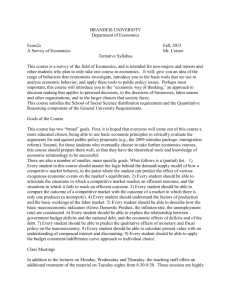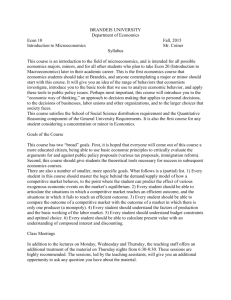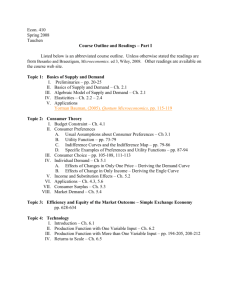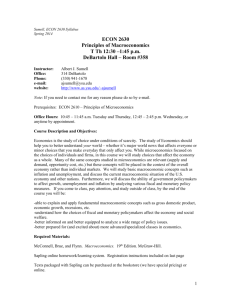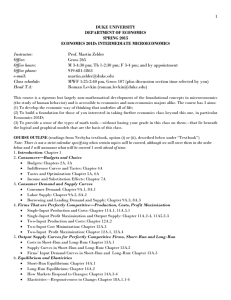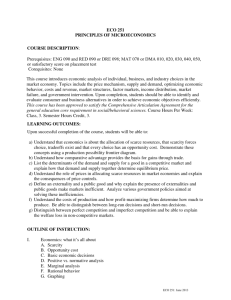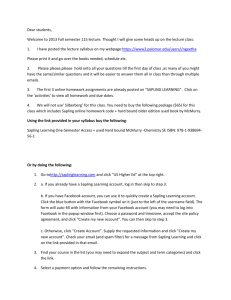Syllabus - Brandeis University
advertisement
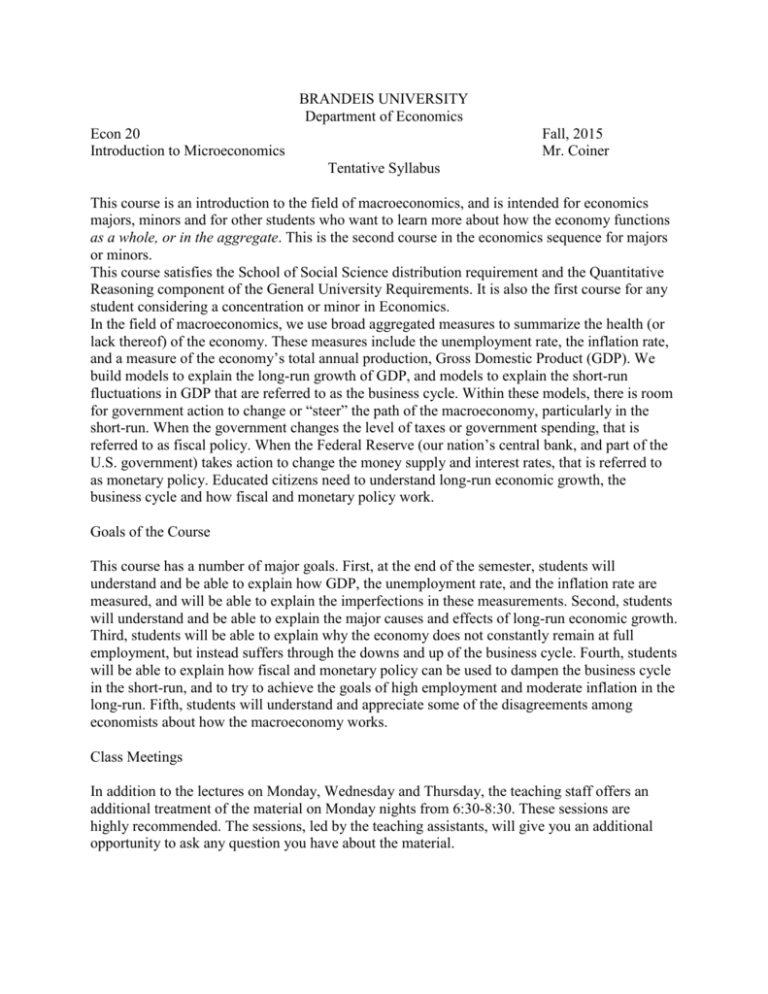
BRANDEIS UNIVERSITY Department of Economics Econ 20 Introduction to Microeconomics Fall, 2015 Mr. Coiner Tentative Syllabus This course is an introduction to the field of macroeconomics, and is intended for economics majors, minors and for other students who want to learn more about how the economy functions as a whole, or in the aggregate. This is the second course in the economics sequence for majors or minors. This course satisfies the School of Social Science distribution requirement and the Quantitative Reasoning component of the General University Requirements. It is also the first course for any student considering a concentration or minor in Economics. In the field of macroeconomics, we use broad aggregated measures to summarize the health (or lack thereof) of the economy. These measures include the unemployment rate, the inflation rate, and a measure of the economy’s total annual production, Gross Domestic Product (GDP). We build models to explain the long-run growth of GDP, and models to explain the short-run fluctuations in GDP that are referred to as the business cycle. Within these models, there is room for government action to change or “steer” the path of the macroeconomy, particularly in the short-run. When the government changes the level of taxes or government spending, that is referred to as fiscal policy. When the Federal Reserve (our nation’s central bank, and part of the U.S. government) takes action to change the money supply and interest rates, that is referred to as monetary policy. Educated citizens need to understand long-run economic growth, the business cycle and how fiscal and monetary policy work. Goals of the Course This course has a number of major goals. First, at the end of the semester, students will understand and be able to explain how GDP, the unemployment rate, and the inflation rate are measured, and will be able to explain the imperfections in these measurements. Second, students will understand and be able to explain the major causes and effects of long-run economic growth. Third, students will be able to explain why the economy does not constantly remain at full employment, but instead suffers through the downs and up of the business cycle. Fourth, students will be able to explain how fiscal and monetary policy can be used to dampen the business cycle in the short-run, and to try to achieve the goals of high employment and moderate inflation in the long-run. Fifth, students will understand and appreciate some of the disagreements among economists about how the macroeconomy works. Class Meetings In addition to the lectures on Monday, Wednesday and Thursday, the teaching staff offers an additional treatment of the material on Monday nights from 6:30-8:30. These sessions are highly recommended. The sessions, led by the teaching assistants, will give you an additional opportunity to ask any question you have about the material. Exams Two Monday night sessions of the semester will require mandatory attendance in order to administer midterm exams. The dates of these two midterms are Monday, October 12th and Monday, November 9th. There will also be a final exam during finals week at a time and place determined by the Registrar. Problem Sets There will be two types of problem sets in this course. There will be one electronic problem set for each chapter of the text that we cover (about a dozen in all). There will also be 11 oldfashioned hard copy problem sets. More details about these problem sets are given below. Text The text for this course is Macroeconomics: Principles & Applications (6th edition) by Robert E. Hall and Marc Lieberman. In addition to the text, everyone is required to sign up for Sapling Learning, which is the source of the electronic problem sets. The cost of signing up for Sapling Learning is approximately $40. Signing Up for Sapling Learning DO NOT SIGN UP FOR SAPLING UNTIL AFTER THE FIRST CLASS MEETING IN AUGUST. 1. Go to http://saplinglearning.com 2a. If you already have a Sapling Learning account, log in then skip to step 3. 2b. If you have Facebook account, you can use it to quickly create a SaplingLearning account. Click the blue button with the Facebook symbol on it (just to the left of the username field). The form will auto-fill with information from your Facebook account (you may need to log into Facebook in the popup window first). Choose a password and timezone, accept the site policy agreement, and click "Create my new account". You can then skip to step 3. 2c. Otherwise, click "Create account". Supply the requested information and click "Create my new account". Check your email (and spam filter) for a message from Sapling Learning and click on the link provided in that email. 3. Find your course in the list (you may need to expand the subject and term categories) and click the link. 4. Select a payment option and follow the remaining instructions. Once you have registered and enrolled, you can log in at any time to complete or review your homework assignments. During sign up - and throughout the term - if you have any technical problems or grading issues, send an email to support@saplinglearning.com explaining the issue. The Sapling support team is almost always more able (and faster) to resolve issues than your instructor. Grading Policy Your grade is based on 3 exams and on both types of problem sets. There will be 11 hard-copy problem sets. Four of these sets arrive just before an exam, and these do not have to be turned in. Of the remaining 7 problem sets, you may omit turning in one. Thus, to get full credit for the hard-copy problem sets, you will have to turn in 6 of the 7 required problem sets. The hard-copy problem sets will make up 10% of your grade. There will be approximately a dozen electronic problem sets. Sapling will automatically record your scores on these problem sets. The lowest three scores during the term will be thrown out. Your score on the remaining electronic problem sets will constitute 10% of your grade. Whichever midterm you score higher on will count for 30% of your grade. The other midterm will count for 20% of your grade. The final exam will count for 30% of your grade. The remaining 20% of your grade will be based on the problem sets (as described above). Information Dissemination In Economics 20 we will maintain a course website through the University’s Latte system. You will be responsible for checking the website frequently as most of the problem sets, answer keys, etc. will be posted there and available for you to download. The website can be accessed from webct.brandeis.edu. Most items on the course website are PDF or DOC files. Doing Your Best Here are some suggestions that may help you to do well in Economics 20: Do the assigned reading before class to get a preview of the material to be covered and to prepare any questions you have about this material. Take the problem sets seriously, because they are the best indication of whether you understand the material and they are the best preparation for the exams. Come to class. Keep up with the work. Special Accommodations If you are a student with a documented disability at Brandeis University and if you wish to request a reasonable accommodation for this class, please see me right away. Please keep in mind that reasonable accommodations are not provided retroactively. IF YOU EXPERIENCE AN ILLNESS OR FAMILY EMERGENCY THAT WILL KEEP YOU FROM ATTENDING CLASS FOR A WEEK OR MORE, YOU MUST CONTACT YOUR ADVISOR AT ACADEMIC SERVICES SO THAT THEY CAN INFORM ALL YOUR INSTRUCTORS ABOUT THE SITUATION AND REQUEST ACCOMODATIONS FOR YOU. IN THE EVENT THAT YOU ARE UNABLE TO TAKE AN EXAM AT THE SCHEDULED TIME AND NEED TO TAKE A MAKE-UP EXAM, I RESERVE THE RIGHT TO DEDUCT POINTS FROM YOUR SCORE ON THAT EXAM. Academic Honesty You are expected to be honest in your academic work. The University policy on academic honesty is distributed annually as section 4 of the Rights and Responsibilities handbook. Instances of alleged dishonesty will be forwarded to the Office of Campus Life for possible referral to the Student Judicial System. Potential sanctions include failure in the course and suspension from the University. If you have any questions about my expectations, please ask. Academic Dishonesty will not be tolerated and will be rigorously prosecuted. Course Outline The Goals of the Macroeconomy Measuring Production Measuring Employment & Unemployment Measuring the Price Level & Inflation The Classical Long-run Model Long-run Economic Growth Chapter 5 Chapter 6 Chapter 6 Chapter 7 Chapter 8 Chapter 9 FIRST MIDTERM OCTOBER 12TH Short-run Economic Fluctuations The Simplest Short-run Macro Model Fiscal Policy in the Simplest Model Money, Banks & the Federal Reserve Chapter 10 Chapter 11 Chapter 12 Chapter 13 SECOND MIDTERM NOVEMBER 9TH Adding Money to the Short-run Model; Monetary Policy Integrating the Short-run and Long-run; The Aggregate DemandAggregate Supply Model Inflation & Monetary Policy Exchange-rates and the Macroeconomy Chapter 14 Chapter 15 Chapter 16 Chapter 17
